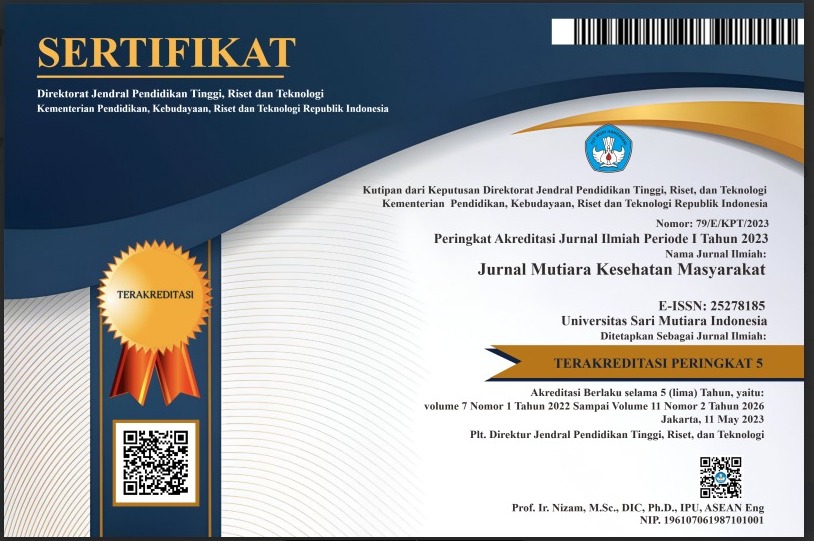HUBUNGAN DUKUNGAN KELUARGA DAN KUALITAS HIDUP LANSIA PENDERITA DM TIPE II DI PUSKESMAS BAKTIRAJA, HUMBANG HASUNDUTAN
DOI:
https://doi.org/10.51544/jmkm.v8i1.4233Keywords:
Family Support, Quality life of the elderly, Ttype 2 DMAbstract
The impact of diabetes mellitus includes physical, psychological and social changes in sufferers. One of the common psychological changes experienced is anxiety. Support from family for people with type 2 DM in the form of emotional attention, practical assistance, and assesments provided by family members can help improving physicaly and mental well-being of sufferers and is an important form of social support. This study aims to evaluate the relationship between family support and the quality of life of elderly peopple with type 2 diabetes mellitus at the Baktiraja Health Center, Humbang Hasundutan District. This study used a quabtitative approach with a correlative descriptive method and a cross-sectional design. The research sample consisted of 65 respondents. The result showed that there was a significant relationship between family support and the quality of life of elderly people with type 2 diabetes mellitus at the Baktiraja Health center, Humbang Hasundutan District (p = 0,000). The involvement of family support for human type 2 DM has an importance role in improve heir quality of life. Therefore, health workers can provide appropriate nursing interveitions. One way that’s can be do by nurses to increase family’s support is to provide knowledge through health education and counseling to sufferers and families.
Downloads
References
Aini, Nur Latifah. 2017. ”Faktor-Faktor yang Mempengaruhi Partisipasi Anggota pada Koperasi Mahasiswa Universitas Negeri Yogyakarta”. Jurnal Pendidikan dan Ekonomi 6(3): 195-207.
Alfanani, Rozali Jauhari. 2017. “Bentuk dan Makna Ekspresi Naratif Cerita Rakyat Sasak Doyan Neda: Kajian Ekokritik Sastra”. Jurnal Mabasindo,1 (1). Diakses pada 20 Mei 2021
(http://jurnal.mabasindo.unram.ac.id/index.php/mabasindo/article/downlo ad/6/6)
Anggina, L.L., Hamzah, A. & P. (2015). Hubungan Antara Dukungan Sosial Keluarga dengan Kepatuhan Pasien Diabetes dalam Melaksanakan Program Diet d Poli Penyakit Dalam RSUD Cibabat Cimahi. Jurnal Penelitian Kesehatan Suara Forikes, I, 1–9
Arikunto. (2014). Prosedur penelitian suatu pendekatan praktik. Jakarta: PT Rineka Cipta Association, A. D. (2014). Diagnosis and Classification of Diabetes Mellitus. Diabetes
Care, 581–590. https://doi.org/10.2337/dc14-S081
Firdausi, Zahra. (2014). Hubungan dukungan keluarga dengan kepatuhan melakukan latihan fisik dan terapi insulin pada pasien diabetes mellitus tipe 1 di poliklinik penyakit dalam RSUD DR. Abdoer Rahem Situbondo.
Hartati, I., Pranata, A. D., & Rahmatullah, M. R. (2019). Hubungan Self Care Dengan Kualitas Hidup Pasien Diabetes Melitus Di Poli Penyakit Dalam RSUD Langsa. Jurnal Pendidikan dan Praktik Kesehatan, 2(2), 94-104.
Kemenkes. RI. 2017. Profil Kesehatan Tahun 2015. Jakarta: Kementrian Kesehatan RI.
Luthfa, I. (2018, November). Telemedicine For Diabetes Mellitus Management in Community. In PROCEEDINGS INTERNATIONAL CONFERENCE BKSPTIS 2018
Pebrini (2018). Hubungan dukungan keluarga dengan kualitas hidup lansia yang memiliki riwayat diabetes melitus tipe II di puskesmas Sanggaran Agung Kerinci
PERKENI, 2017, Pengelolaan dan Pencegahan Diabetes Melitus Tipe 2 di Indonesia, PERKENI, Jakarta.
Nuryanti (2015). Faktor-faktor yang mempengaruhi kualitas idup pasien diabetes melitus tipe II di wilayah kerja puskes sungai ulin Banjarbaru.
Nursalam. (2016). Metodologi Penelitian Ilmu Keperawatan. Jakarta: Salemba Medika.
Notoamtmodjo. (2010). Metodologi Penelitian Kesehatan. Jakarta: PT RinekaCipta.
Risnasari, Norma. (2014). Hubungan tingkat kepatuhan diet pasien diabetes mellitus dengan munculnya komplikasi di Puskesmas Pesantren II Kota Kediri. Efektor, 25 (01): 15-19
Robinson, V.M. (2010). The Relative Roles of Family and Peer Support in Metabolic Control and Quality of Life for Adolescents with Type 1 Diabetes. The University of Edinburgh. Diperoleh 2 Mei 2021, dari http://www.Mendeley.com/research
Setiadi. (2008). Konsep & Proses Keperawatan Keluarga. Yogyakarta: Mitra Cendikia Press.
Srikartika, V. M., Cahya, A. D., Suci, R., Hardiati, W., & Srikartika, V. M. (2015).Analisis Faktor Yang Memengaruhi Kepatuhan Penggunaan Obat Pasien Diabetes Melitus Tipe 2 the Analysis of the Factors Affecting Medication Adherence in Patients, (2011), 205–212..
Soegondo, S. (2016). Fakmakoterapi pada pengendalian glikemia diabetes melitus tipe 2. Buku ajar ilmu penyakit dalam. Jakarta: Pusat Penerbitan Departemen Ilmu Penyakit Dalam Fakultas Kedokteran Universitas Indonesia
Setiyorini, E., &Wulandari, N. A. (2017). Hubungan Lama Menderita Dan Kejadian Komplikasi Dengan Kualitas Hidup Lansia Penderita Diabetes Mellitus. Research Report, 75-82
Taluta, Y. P., Mulyadi & Hamel, R. S., 2014. Hubungan Tingkat Kecemasan Dengan Mekanisme Koping pada Penderita Diabetes MelitusTipe 2 Di Poliklinik Peyakit Dalam Rumah Sakit Umum Daerah Tobelo Kabupaten
Halmahera Utara. Ejourna lkeperawatan, 1(2), pp. 1-9
World Health Organization. (2016). Global Report on Diabetes. France: World Health Organization. Retrieved from .
Yusra, A. (2010). Hubungan antara dukungan keluarga dengan kualitas hidup pasien Diabetes Mellitus Tipe 2 di poliklinik penyakit dalam rumah sakit umum pusat Fatmawati Jakarta. Tesis.http://www.who.int/diabetes/global- report/en/.
Downloads
Published
How to Cite
Issue
Section
License
Copyright (c) 2023 Flora Sijabat, Rinco Siregar, Darwita J Barus

This work is licensed under a Creative Commons Attribution-ShareAlike 4.0 International License.













.png)



